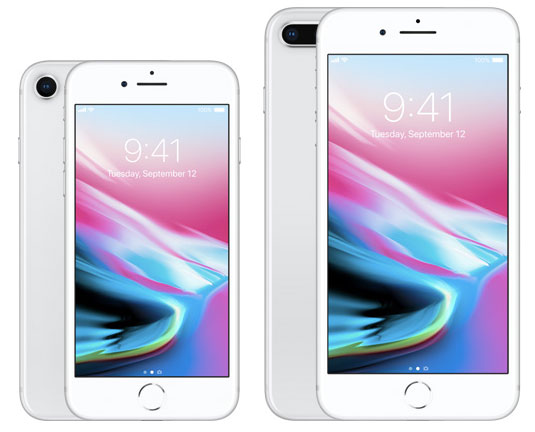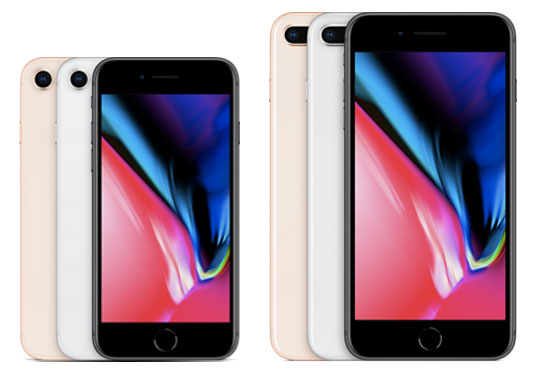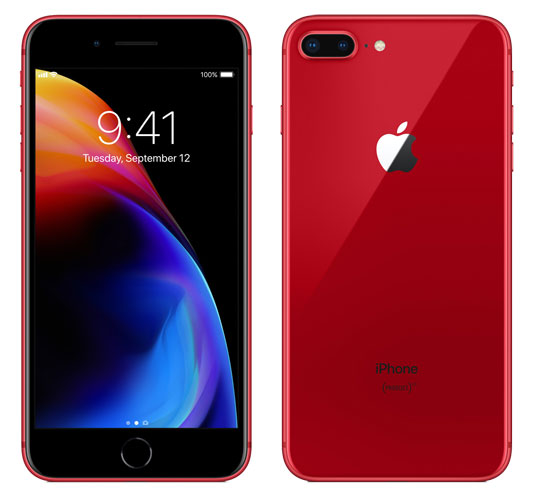Hosted by site sponsor WebMate.
iPhone Q&A
Update Published December 7, 2022
All Apple Q&As >> iPhone Q&A (Home) | iPhone Repair Q&A (Home)
To be notified of new Q&As, sign up for EveryMac.com's bimonthly email list.
What are all the differences between the iPhone 8 and iPhone 8 Plus models? How many different versions are there?
Please note that the iPhone 8 and iPhone 8 Plus models have been discontinued. However, this Q&A has been updated with the latest configuration, pricing, and iOS support details and be quite helpful to anyone buying or selling one of these devices on the used market.
With a brief glance at the iPhone 8 and iPhone 8 Plus, it would not be unexpected for one to conclude that the iPhone 8 Plus is merely a bigger version of the iPhone 8.
Although the different dimensions and display sizes are important, there are other differences that are perhaps equally important if not more so.

Photo Credit: Apple, Inc. (iPhone 8 - Left, iPhone 8 Plus - Right)
Additionally, there are at least four iPhone 8 and four iPhone 8 Plus models that were sold on different carriers and in different markets around the world. Specifically, there is the iPhone 8 (Verizon/Sprint/China), iPhone 8 (AT&T/T-Mobile/Global), iPhone 8 (Japan), and iPhone 8 (China Mobile) as well as the iPhone 8 Plus (Verizon/Sprint/China), iPhone 8 Plus (AT&T/T-Mobile/Global), iPhone 8 Plus (Japan), and iPhone 8 Plus (China Mobile).
There are network support and distribution differences between these models that are important to understand. It is useful to know the similarities that the models share, too.
External Differences & Similarities
Both the iPhone 8 and iPhone 8 Plus models use an aluminum alloy case reinforced by steel with a glass front and back and are splash, water, and dust-resistant (IP67), but they are not fully waterproof.
Both models also have "wireless" -- or really inductive -- charging capability, as well as stereo speakers, a Lightning port, and a solid state "clickless" Home button with integrated "Touch ID" fingerprint capabilities.
Additionally, both devices have a multitouch True Tone "Retina HD" display with support for a "wide color" gamut (DCI-P3), dual domain pixels, 625 cd/m2 maximum brightness, and 3D touch capabilities.
However, the 4.7" (1334x750) display in the iPhone 8 has a slightly better typical contrast ratio (1400:1) compared to the 5.5" (1920x1080) display in the iPhone 8 Plus, which has a 1300:1 typical contrast ratio. On the other hand, the iPhone 8 Plus has a higher pixel density, 401 ppi compared to 326 ppi for the iPhone 8.

Photo Credit: Apple, Inc. (iPhone 8 - Left, iPhone 8 Plus - Right)
Originally, both models were available in three color options -- gold, silver, and a dark "Space Gray." The gold and silver options have a white front and the dark option has a black front.

Photo Credit: Apple, Inc. (iPhone 8 Plus - Red Color Option)
From April 9, 2018 until September 12, 2018, Apple also sold a (PRODUCT) RED Special Edition option for both the iPhone 8 and iPhone 8 Plus. These options have a black front and a red back.
Camera Differences
The iPhone 8 and iPhone 8 Plus both use the same front-facing "FaceTime HD" camera. This camera has a 7 megapixel sensor, an f/2.2 aperture, and records 1080p HD video.
The rear cameras, though, are substantially different from one another.
The iPhone 8 has a rear camera with a 12 megapixel sensor, an f/1.8 aperture, and digital zoom up to 5x. The iPhone 8 Plus, on the other hand, has two rear cameras -- a 12 megapixel wide-angle camera with a an f/1.8 aperture and a 12 megapixel telephoto camera with a f/2.8 aperture. Collectively, these two cameras provide an effective optical zoom as well as digital zoom up to 10x for still photos and up to 6x for video recording. The iPhone 8 Plus also has a portrait mode and a "Portrait Lighting" feature, as well.
Both models have optical image stabilization and the rear cameras are capable of recording 4K video (3840x2160) at 30 fps, 1080p video at 30 fps or 60 fps (as well as 120 fps for 1080p slo-mo and 240 fps for 720p video).
Identification Differences
It is simple to differentiate between the iPhone 8 and iPhone 8 Plus when both are next to one another, but identifying the specific iPhone 8 or iPhone 8 Plus is more difficult. Likewise, it can be easy to confuse these iPhone models with earlier or later models.
Unfortunately, unlike previous iPhone models, the iPhone 8 and iPhone 8 Plus cannot be uniquely identified by Model Number on the back of each device. However, the model number is listed on the cardboard shipping box and within the iOS "Settings" app.
Consequently, for the purpose of this Q&A, it is sufficient to note that the following model numbers refer to these devices:
iPhone Model |
Model No |
EveryiPhone.com's Ultimate iLookup feature also can precisely identify these iPhone models by Order Number (referred to as "Model" within the iOS "Settings" app under General > About), and their Serial Numbers, as well.
Battery Life Differences
Battery life is another significant point of differentiation between the iPhone 8 and iPhone 8 Plus:
| iPhone 8 | iPhone 8 Plus | |
| Talk Time (3G) | 14 Hours | 21 Hours |
| Internet Use (3G) | 12 Hours | 13 Hours |
| Internet Use (4G/LTE) | 12 Hours | 13 Hours |
| Internet Use (Wi-Fi) | 12 Hours | 13 Hours |
| Video Playback | 13 Hours | 14 Hours |
| Audio Playback | 40 Hours | 60 Hours |
Ultimately, the larger iPhone 8 Plus has a physically larger battery, and it provides more runtime accordingly.
Wireless Connectivity & Data Differences
All iPhone 8 and iPhone 8 Plus models support FDD-LTE (Bands 1, 2, 3, 4, 5, 7, 8, 12, 13, 17, 18, 19, 20, 25, 26, 28, 29, 30, and 66) and TD-LTE (Bands 34, 38, 39, 40, and 41) as well as GSM/EDGE (850, 900, 1800, 1900 MHz), 802.11ac Wi-Fi with MIMO, and Bluetooth 5.
Perhaps for most users, the most important connectivity difference between models is that the iPhone 8 (AT&T/T-Mobile/Global) A1905 and iPhone 8 (China Mobile) A1907 as well as the iPhone 8 Plus (AT&T/T-Mobile/Global) A1897 and iPhone 8 Plus (China Mobile) A1899 do not support CDMA EV-DO Rev. A (800, 1900, 2100 MHz) and TD-SCDMA 1900 (F), 2000 (A) connectivity whereas the other two models do.
However, the Japan-specific models, the iPhone 8 (Japan) A1906 and iPhone 8 Plus (Japan) A1898, also support LTE bands 11 (1500 MHz), 21 (1500 MHz), and 42 (TD 3500), whereas the other models do not.
Internal Differences & Similarities
In terms of specific parts, there are many internal differences between the iPhone 8 and iPhone 8 Plus. The displays, cameras, and batteries are different as are a number of other internal components. One particularly major difference is that the iPhone 8 has 2 GB of RAM whereas the iPhone 8 Plus has 3 GB of RAM.
Otherwise, the iPhone 8 and iPhone 8 Plus are quite similar. Both use a 2.4 GHz six core "A11 Bionic chip with 64-bit architecture" as well as pack an "embedded M11 motion coprocessor" and originally were equipped with either 64 GB or 256 GB of flash storage (on September 10, 2019, Apple discontinued the 256 GB option and introduced a 128 GB replacement).
Both devices also have an NFC (Near Field Communication) chip with reader mode to allow digital payments in conjunction with "Apple Pay" software, too.
The Japan-specific models -- the iPhone 8 (Japan) A1906 and iPhone 8 Plus (Japan) A1898 -- additionally are advertised to support Sony's FeliCa for contactless payments on iD and QuicPay as well as Suica support on JR East.
iOS Support Similarities
The iPhone 8 and iPhone 8 Plus both originally shipped with iOS 11 and later shipped with iOS 12 and iOS 13. They also are compatible with iOS 14 and iOS 15, as well as the current version of the iOS -- iOS 16 -- although a variety of features are not supported.
Running iOS 13, the iPhone 8 models not support the Adjust Portrait Lighting and High-Key Mono photgraphy features, Dolby Atmos playback and modest AR features (Motion Capture and People Occlusion).
Running iOS 14, the iPhone 8 models do not support the minor Car Keys, Location Anchors, Exposure Compensation, Burst Photos, QuickTake Video, and On-Device Dictation features.
Running iOS 15, the iPhone 8 models do not support a large number of advanced features including Spatial Audio, Portrait Mode, Immersive Walking Instructions, Live Text in Photos, Live Text Translation, Visual Look Up, 3D Landmarks, Home Keys, and more.
Finally, running iOS 16, the iPhone 8 models do not support many advanced features including Live Text, expanded Siri capabilities, improved Dictation, Adding medications via camera, Accessibility Detection, Live Captions, improved Depth of Field, and Visual Look Up. They do not support Apple Music Sing (Karaoke), either.
iPhone 8 & iPhone 8 Plus Comparison Chart
These differences -- displays, cameras, battery life, and dimensions -- as well as other details and pricing information are summarized below:
 iPhone 8 |
 iPhone 8 Plus |
|
|---|---|---|
| Display Size: | 4.7" | 5.5" |
| Display Resolution: | 1334x750 | 1920x1080 |
| Pixel Density: | 326 ppi | 401 ppi |
| Contrast Ratio: | 1400:1 | 1300:1 |
| RAM: | 2 GB | 3 GB |
| Front Camera: | 7 Megapixels | 7 Megapixels |
| Rear Camera(s): | 12 Megapixels | 12 Megapixels x 2 |
| Rear Zoom: | 5x Digital | 2x Optical, 10x Digital |
| Rear Zoom (Video): | 3x Digital | 2x Optical, 6x Digital |
| Portrait Mode: | No | Yes |
| Portrait Lighting: | No | Yes |
| Talk Time (3G): | 14 Hours | 21 Hours |
| 3G Battery Life: | 12 Hours | 13 Hours |
| 4G Battery Life: | 12 Hours | 13 Hours |
| Wi-Fi Battery Life: | 12 Hours | 13 Hours |
| Video Playback: | 13 Hours | 14 Hours |
| Audio Playback: | 40 Hours | 60 Hours |
| Connector Type: | Lightning | Lightning |
| SIM Card: | Nano | Nano |
| Apple Pay (NFC): | Yes | Yes |
| Touch ID: | Yes | Yes |
| FeliCa: | Japan Only (A1906) | Japan Only (A1898) |
| Dimensions: | 5.45 x 2.65 x 0.29* | 6.24 x 3.07 x 0.30* |
| Weight: | 5.22 oz. (148 g) | 7.13 oz. (202 g) |
| Original Price (US†): | US$699, US$849 | US$799, US$949 |
| Original Price (UK†): | £699, £849 | £799, £949 |
| Original Price (CA†): | C$929, C$1139 | C$1059, C$1269 |
| Original Price (AU†): | A$1079, A$1329 | A$1229, A$1479 |
| Original Price (JP†): | ¥78,800, ¥95,800 | ¥89,800, ¥106,800 |
| Original Price (CN†): | RMB 5,888, 7,188 | RMB 6,888, 7,988 |
* In inches, height x width x depth.
† These prices are unlocked and contract-free. Carrier subsidized and lease options also are available in many markets. On September 12, 2018, Apple cut the price in the US to US$599 and US$749 for the iPhone 8 and US$699 and US$849 for the iPhone 8 Plus. Finally, on September 10, 2019, Apple discontinued the 256 GB option and introduced a new 128 GB one. With 64 GB or 128 GB of storage, the iPhone 8 finally was offered for US$449 or US$499. It was discontinued entirely on April 15, 2020.
So, should I buy an iPhone 8 or iPhone 8 Plus? Which is best for me?
Even just compared to one another, and ignoring earlier models and later models, the iPhone 8 and iPhone 8 Plus may be a difficult decision for some users.
If physical size is most important -- you want a mobile device that you likely can comfortably grasp with one hand and easily store in a pocket in a pair of pants -- the iPhone 8 is your best choice. Alternately, the rear camera on the iPhone 8 Plus is substantially better and it also has a larger display and longer battery life (although neither of these iPhone models have a camera that is remarkable compared to later models).
However, the iPhone 8 is cheaper, which could be important to you if you are on a budget. If price is of concern, though, you might also want to consider a used iPhone 6s or iPhone 6s Plus or iPhone 7 or iPhone 7 Plus that also are quite capable and are cheaper still. Those with higher budgets likely would prefer a newer iPhone model, though.
In the US, site sponsors Other World Computing and JemJem sell used and refurbished iPhone 8/iPhone 8 Plus models with free shipping. On the other hand, if you need to sell an iPhone, A+ BBB-rated Cash for Your Mac and GoRoostr will buy your older iPhone with an instant quote and prompt payment.
In Australia, site sponsor Mac City likewise has a variety of used iPhone models sold at low prices and available with a free warranty and fast shipping across Australia.
Site sponsor OWC also sells high quality NuGuard KX cases for the iPhone 8 and iPhone 8 Plus. Because these models largely are glass, a protective case is a particularly good idea.
Please also see EveryiPhone.com's Ultimate iComparison feature to dynamically compare any iPhone model to any other iPod, iPhone, or iPad.
Permalink | Report an Error/Typo | Sign Up for Site Update Notices
<< iPhone Q&A (Main) | All Apple Q&As
Established in 1996, EveryMac.com has been created by experts with decades of experience with Apple hardware. EveryMac.com includes, and always has included, original research incorporating detailed, hands-on inspection of packaging, computers, and devices as well as extensive real-world use. All information is provided in good faith, but no website or person is perfect. Accordingly, EveryMac.com is provided "as is" without warranty of any kind whatsoever. EveryMac.com, and the authors thereof, shall not be held responsible or liable, under any circumstances, for any damages resulting from the use or inability to use the information within. For complete disclaimer and copyright information please read and understand the Terms of Use and the Privacy Policy before using EveryMac.com. Copying, scraping, or use of any content without expressed permission is not allowed, although links to any page are welcomed and appreciated.
